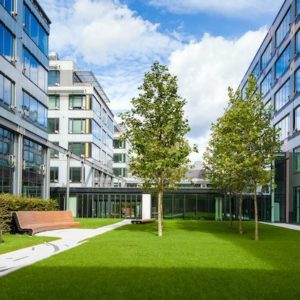The challenges of changing consumer habits and the effects of the pandemic have caused ample hardship for America’s malls. Many have struggled to stay financially viable, and many have closed.

CNBC reports that 25 percent of U.S. malls are expected to close within the next five years. These vacant buildings will require new purposes. While conversion to industrial spaces may seem like the most obvious answer, many of these properties will require rezoning to fit this new purpose. Municipalities are often hesitant to enact zoning changes as tax revenues consequently fall.
New purposes through adaptive reuse
Adaptive reuse – where an existing building is repurposed for a use other than its original design – offers immense opportunities for former retail sites to take on a new life. Large malls are typically located near highways and public transit offerings, making them attractive to redevelopment opportunities.
Adaptive reuse principles can apply to a portion of the property rather than for a complete overhaul. For example, if large anchor tenants within malls have little prospect of returning, these spaces can be revamped into multifamily housing, creating an active community surrounding the retail environment. Examples are already popping up. Per Propmodo,
Some might think that living in a mall is particularly nightmarish, but well-executed projects could look much like normal mixed-use developments, or manifest as separate residential towers surrounded by well-manicured landscaping, and not just like small apartments crammed into vacant big box shells. Projects that add residential space to malls are already underway. In a northern suburb of Seattle, Alderwood Mall is developing 300 apartments that will complement the remaining 90,000 square feet of retail space at the property.
There are also cases where former malls and department stores have been transformed into schools, office spaces, wellness centers, hotels and entertainment venues.
Creating destinations
Real estate services provider CBRE notes a trend in landlords revitalizing their properties by creating themed destinations.
Another experimental trend in malls is repurposing space to suit one common theme. For example, a struggling mall might opt to focus on health, transforming anchor spaces into exercise facilities or alternative gym formats and then tailor the rest of the tenant mix to serve this consumer base. Another option in this category is healthcare. To meet an increasing demand for healthcare facilities, some investors are switching gears with their malls, filling space with doctor or hospital groups that have high square footage needs for their campuses. Accompanying retail targeted at these consumers can then fill out in-line spaces where needed.
Some smaller retailers have bucked the store closure trend, and very recently optimism is on the upswing – a complete about-face from 2020. Coresight Research tracked 8,953 store closures last year with 3,298 openings. However, for 2021 year to date, the firm tracked 2,548 closures with retailers announcing 3,199 store openings. This is the first time in years that store openings may surpass store closures. With space available and rents on the decline, let’s not count the retail sector out just yet.


